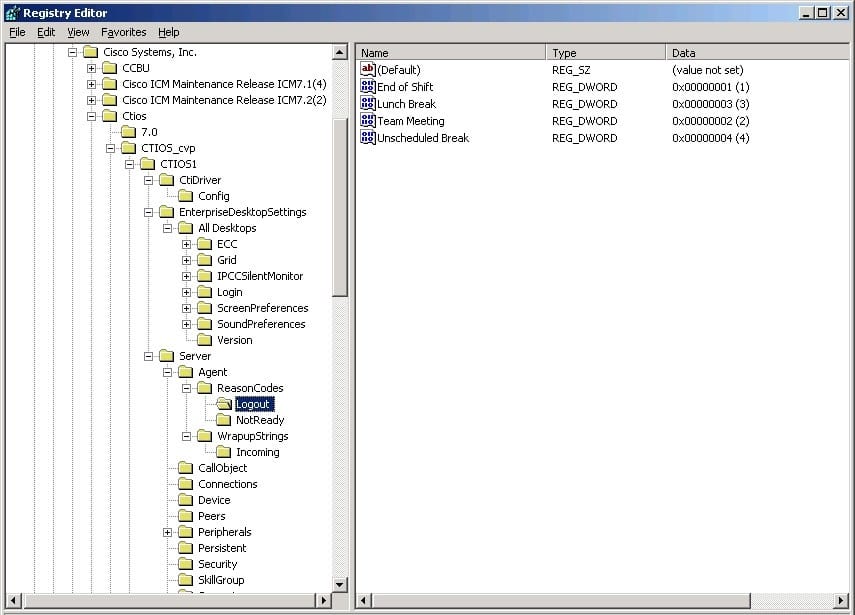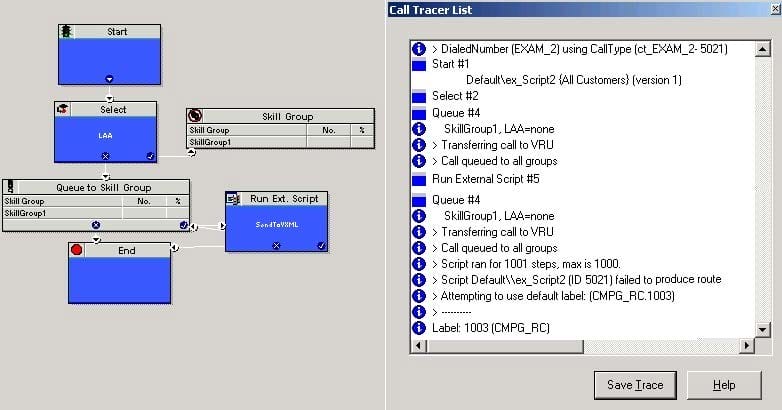Exam Details
Exam Code
:642-242Exam Name
:Unified Contact Center Enterprise Implementation(UCCEI)Certification
:Cisco CertificationsVendor
:CiscoTotal Questions
:84 Q&AsLast Updated
:Mar 26, 2025
Cisco Cisco Certifications 642-242 Questions & Answers
-
Question 21:
In the Cisco Unified Contact Center Enterprise solution, how are CTI route points and CTI ports created in the Unified IP IVR 4.0(x)?
A. CTI route points and CTI ports are created and associated to the IP IVR user in Cisco Unified Communications Manager Administration prior to configuring the CTI route points in the IP IVR in the CRS Administration menu.
B. CTI route points and CTI ports are created from the CRS Administration menu. The CRS Administration will automatically create and associate the CTI route points and CTI ports in Unified Communications Manager.
C. CTI route points and CTI ports are created from the CRS Administration first and then the CTI route points and CTI ports are associated to the correct user using Unified Communications Manager Administration manually.
D. CTI route points and CTI ports can either be created from the CRS Administration menu or from the Cisco Unified Communications Manager Administration as long as the CTI route points and CTI ports are associated to the correct IP IVR user profile.
-
Question 22:
When planning an upgrade for the Cisco Unified Contact Center Enterprise solution, what is the proper order for upgrading the solution components?
A. Upgrade the Cisco Unified Communications Manager cluster. Upgrade the Cisco Unified Communications Manager Peripheral Gateways. Upgrade the Administration and Data servers. Upgrade the Call Router and Logger servers.
B. Upgrade the Cisco Unified Communications Manager Peripheral Gateways. Upgrade the Cisco Unified Communications Manager cluster. Upgrade the Call Router and Logger servers. Upgrade the Administration and Data servers.
C. Upgrade the Call Router and Logger servers. Upgrade the Administration and Data servers. Upgrade the Cisco Unified Communications Manager Peripheral Gateways. Upgrade the Cisco Unified Communications Manager cluster.
D. Upgrade the Administration and Data servers. Upgrade the Call Router and Logger servers. Upgrade the Cisco Unified Communications Manager cluster. Upgrade the Cisco Unified Communications Manager Peripheral Gateways.
-
Question 23:
In the Cisco Unified Contact Center Enterprise solution, how is the supervisor account/login created?
A. created manually in the Cisco Agent Desktop Administrator
B. created as a user in the Microsoft Windows Active Directory
C. created with permission to the Cisco Root ICM Setup group via the ICM Domain Manager tool
D. created with an association to one and only one skill group for their team
-
Question 24:
When configuring a Cisco Unified Communications Manager dial plan to allow for dialing 911 or placing other emergency calls, where should Urgent Priority be checked off in?
A. route pattern
B. route list
C. route group
D. calling search space
-
Question 25:
Which Cisco Unified Contact Center Enterprise Script node is used to capture call flow data within the branches of the script and show the count in a report?
A. Call Type node
B. Run External Script node
C. Label node
D. Comment node
-
Question 26:
Which is the recommended order of installation for Cisco Unified ICM software components?
A. Call Router, Logger, first Admin Workstation/Distributor, Peripheral Gateway
B. First Admin Workstation/Distributor, Call Router, Logger, Peripheral Gateway
C. Peripheral Gateway, first Admin Workstation/Distributor, Logger, Call Router
D. Logger, Call Router, Peripheral Gateway, first Admin Workstation/Distributor
-
Question 27:
The reason codes for the Cisco CTI OS Desktop clients are controlled by the registry keys of the Cisco CTI OS Server. The Cisco Unified ICM database tracks the reason codes.

What will be stored in the Cisco Unified ICM database for the "Lunch Break" logout reason code?
A. The text from the registry key "Lunch Break"
B. The number three (3)
C. The number two (2) because it is the second in the list
D. ICM does not track logout reason codes for agents in the Cisco Unified ICM Database
-
Question 28:
When building a duplexed Cisco Unified ICM Call Router or Peripheral Gateway, there are at least two network cards that need to be configured, visible and private.
Which network card options should not be enabled on the private card? (Choose two.)
A. Client for Microsoft Networks and Internet Protocol (TCP/IP)
B. Cisco Discovery Protocol Packet Driver and File and Printer Sharing for Microsoft Networks
C. File and Printer Sharing for Microsoft Networks and Internet Protocol (TCP/IP)
D. Client for Microsoft Networks and File and Printer Sharing for Microsoft Networks
E. Internet Protocol (TCP/IP) and Network Monitor Tools
F. Microsoft Telnet and WINS Client
-
Question 29:
The Cisco Unified ICM Call Tracer tool allows ICM script developers to simulate calls in routing scripts for testing purposes.

Given this script and Call Tracer output, what can you conclude?
A. There were no agents logged into Skill Group 1.
B. There were no agents in Skill Group 1 in the Available state.
C. There was no default label defined for this dialed number (EXAM_2).
D. This is not a valid script and would not produce a route.
-
Question 30:
Which steps are used to configure a calling search space in the Cisco Unified Communications Manager 6.1?
A. call routing, dial rules, application dial rules
B. call routing, class of control
C. device, device settings
D. device, remote destination
Related Exams:
300-915
Developing Solutions using Cisco IoT and Edge Platforms (DEVIOT)300-920
Developing Applications for Cisco Webex and Webex Devices (DEVWBX)352-011
Cisco Certified Design Expert Practical500-052
Cisco Unified Contact Center Express500-173
Designing the FlexPod Solution (FPDESIGN)500-174
Implementing and Administering the FlexPod Solution (FPIMPADM)500-201
Deploying Cisco Service Provider Mobile Backhaul Solutions500-210
SP Optical Technology Field Engineer Representative500-220
Cisco Meraki Solutions Specialist500-230
Cisco Service Provider Routing Field Engineer
Tips on How to Prepare for the Exams
Nowadays, the certification exams become more and more important and required by more and more enterprises when applying for a job. But how to prepare for the exam effectively? How to prepare for the exam in a short time with less efforts? How to get a ideal result and how to find the most reliable resources? Here on Vcedump.com, you will find all the answers. Vcedump.com provide not only Cisco exam questions, answers and explanations but also complete assistance on your exam preparation and certification application. If you are confused on your 642-242 exam preparations and Cisco certification application, do not hesitate to visit our Vcedump.com to find your solutions here.